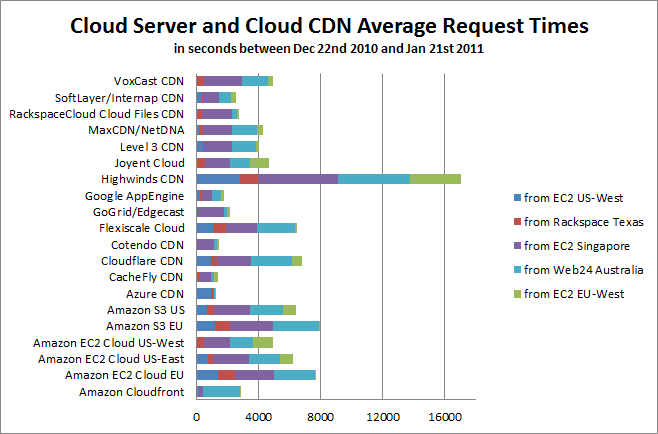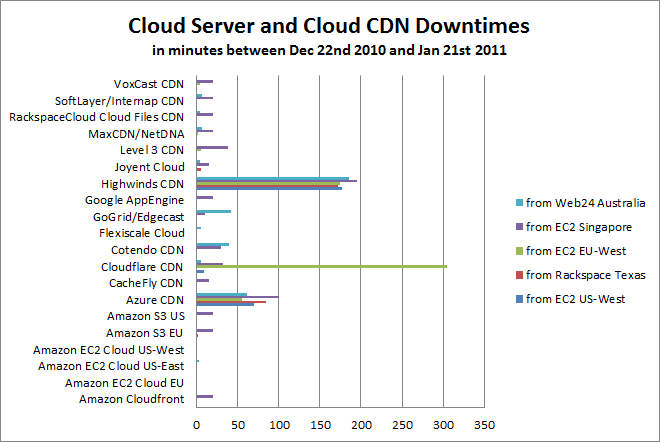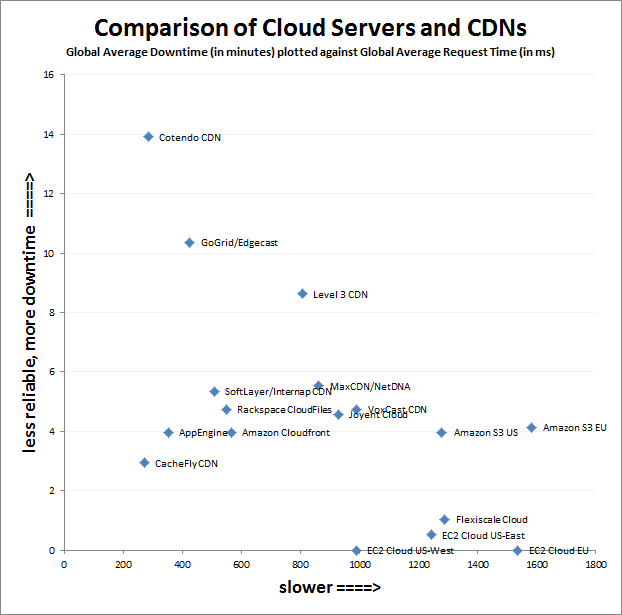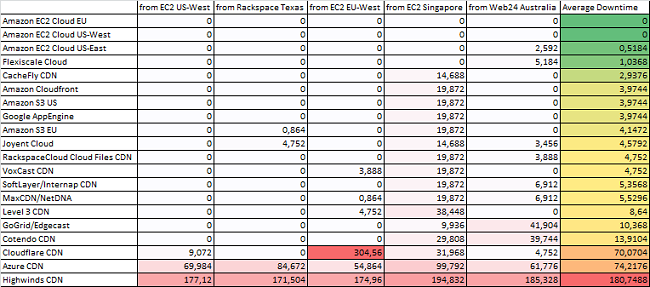Monitoring CDN Services and Cloud Servers Using a Globally Distributed PRTG Cluster
 Originally published on January 19, 2011 by Dirk Paessler
Originally published on January 19, 2011 by Dirk Paessler
Last updated on January 23, 2024
•
8 minute read
One of our test and demo websites for PRTG is a 5-way cluster which has cluster nodes in California, Texas, Ireland, Singapore, and Australia.
With this cluster we are continuously monitoring 20 URLs of cloud servers and CDN services (one monitoring request every 5 minutes from each cluster node). Today I would like to share some of our results from the last 30 days.
The PRTG Cluster
All measurements shown below were created using a 5-way cluster of our software PRTG Network Monitor.
. 

The 5 cluster nodes are running on:
- Amazon EC2 US West (California)
- RackSpaceCloud (Texas)
- Amazon EC2 EU West (Ireland)
- Amazon EC2 APAC (Singapore)
- Web24 (Australia)
The Monitored Servers
In a PRTG cluster all nodes are permanently connected to each other to run as a distributed and failsafe monitoring system. The nodes are automatically synchronized to monitor a specified set of network devices or services. In this case we are monitoring 20 URLs, a 64 kbyte GIF file served by the following servers, and CDNs (either using our own accounts or accounts from our friends by clicking here):
- Amazon EC2 Cloud EU
- Amazon EC2 Cloud US-West
- Amazon EC2 Cloud US-East
- Amazon Cloudfront
- Amazon S3 US
- Amazon S3 EU
- Flexiscale Cloud
- CacheFly CDN
- Google AppEngine
- Joyent Cloud
- RackspaceCloud Cloud Files CDN
- VoxCast CDN
- SoftLayer/Internap CDN
- MaxCDN/NetDNA
- Level 3 CDN
- GoGrid/Edgecast
- Cotendo CDN
- Cloudflare CDN
- Azure CDN
- Highwinds CDN
Results 1: Average Request Times
The following graph shows the request times (in ms) for each URL from the 5 locations (stacked ontop of each other). The smaller the bar, the faster the service:

From a global perspective the fastest services are Azure, Cotendo, Cachefly, and Google AppEngine. Note: If we disregard the measurements from Australia, Amazon Cloudfrount seems to be the fastest global offering. Since three of our monitoring stations are in Amazon's own datacenters this reading does not fully reflect reality.
Results 2: Downtimes
The following graph shows the total downtimes (in minutes) over 30 days. High values mean high downtimes.
We especially notice Highwinds CDN (180 minutes downtime) and Azure (>60 minutes downtime), both showing downtimes from all 5 cluster locations, during this time we can consider their servers unreachable. All other downtimes are single events observed by only one cluster node, so their services seemed to be up all the time, the downtimes were only regional problems. Obviously the APAC data center of EC2 had connectivity problems for 15-20 minutes which affected some services (purple bars), but not all.
Results 3: Downtimes versus Request Times
From a server we expect reliability AND speed. The following chart shows us that you can not get one without sacrificing the other:
The systems with zero or almost zero downtime (three regions of Amazon EC2 as well as the Flexiscale Cloud) are all not very fast from a global perspective (1000-1600ms), compared to the fast CDNs (250-600ms). The fastest CDN on the other hand, Cotendo, has 14 minutes of downtime. BTW, we left Azure, Highwinds, and Cloudflare out of this chart, their downtime values were too far off scale.
The Verdict of January 2011
Looking at the results of this 30 day monitoring effort (in total our servers sent 870.000 requests for this test) I would consider Cachefly CDN and Google AppEngine (which is not even a CDN in the first place) to be the two best offerings. The runner-ups are Amazon Cloudfront, Rackspace Cloudfile, and the Softlayer CDN, all of them are quite close to the two top services. They all are very fast around the globe and show the least downtime, as well. If we leave out the 20 minutes of connectivity issues on the Amazon APAC data center then all these five services would have had zero downtime during our test time. The three services Highwinds CDN, Azure CDN, and Cloudflare had serious downtimes which are not really acceptable for a CDN (IMHO). Finally, here are the detailed numbers for our downtime measurements:







